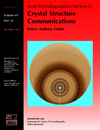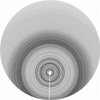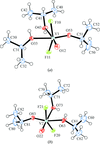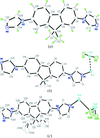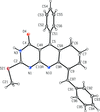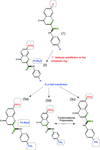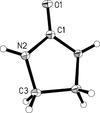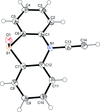issue contents
December 2013 issue
Special issue on Interplay of crystallography, spectroscopy and theoretical methods for solving chemical problems
Guest Editors: Larry Falvello (Universidad de Zaragoza, Spain) and Alberto Albinati (Universita degli Studi di Milano, Italy)

Cover illustration: Powder diffraction: what's in a name? See Von Dreele [Acta Cryst. (2013). C69, 1433-1436]. The paper forms part of the special issue on Interplay of crystallography, spectroscopy and theoretical methods for solving chemical problems.
editorial
Free 

crystallography, spectroscopy and theory
Download citation


Download citation


The co-deposition method was used for preparation of the mixed-valence supramolecular compound {[CuI4(O2CCF3)4]2–{μ2-OC(CH3)2}2–[CuII2(O2CCF3)4]}, which consists of copper(I) and copper(II) trifluoroacetate units held together by acetone bridges and intermolecular Cu⋯O interactions.
CCDC reference: 960993
Download citation


Download citation


Three RuII–hydride species have been synthesized and fully characterized, including X-ray single-crystal structures. Quantum chemical calculations predict very accurately the observed crystallographic data.
Download citation


Download citation


The preparation and structure elucidation of a new tin-rich heterometallic complex [Sn4(hfpt)2–Cu(hfac)2–Sn4(hfpt)2], which consists of a planar [Cu(hfac)2] fragment sandwiched between two tetranuclear [Sn4(hfpt)2] units, are reported.
CCDC reference: 961581
The development of powder diffraction is briefly described; the extent of this development from studies of metals to protein crystal structures shows that powder diffraction is at the cutting edge of crystallography. A new name `polycrystallography' is proposed for these endeavours.
NMR diffusion methods continue to attract increasing attention from practising chemists. This short article summarizes some of the more recent developments and highlights the areas in which these methods are finding application.
Download citation


Download citation


The complex (dtbpe-κ2P)NiI2 is close to square planar in the solid state but is neither diamagnetic nor red in colour. Its structure and magnetism have been investigated by a combination of experiment and density functional theory. Comparisons have been made with analogous compounds bearing different halides and different phosphine ligands. Observed trends in structure and colour have been reproduced theoretically and rationalized.
The analysis of the structures of metastable linkage isomers, generated photochemically, using single-crystal photocrystallographic techniques, is described. The factors that favour the formation of the metastable states are discussed.
inorganic compounds
Download citation


Download citation


Clathrates with the type-I structure are reported in the quaternary Rb–Eu–In–Ge system. Possible cation ordering is suggested.
Download citation


Download citation


The structure of fac-triamminetrichloridorhodium consists of isolated octahedra and that of the fac-triamminetrinitratorhodium trigonal complex consists of octahedral columns with partially filled rhodium positions.
metal-organic compounds
Download citation


Download citation


The ReI centres of the tricarbonylrhenium(I) complexes of 5-[2-(2,4,6-trimethylphenyl)diazen-1-yl]quinolin-8-olate and 5,7-bis[2-(2-methylphenyl)diazen-1-yl]quinolin-8-olate are facially surrounded by the ligands in a slightly distorted octahedral environment. Both structures exhibit intermolecular C—H⋯O interactions.
Download citation


Download citation


The hydrated sodium salt of 4-chloro-3-nitrobenzoic acid and the hydrated sodium and potassium salts of 2-amino-4-nitrobenzoic acid are stabilized by intra- and intermolecular hydrogen bonding and strong π–π ring interactions. Na centres are linked through centrosymmetric four-membered duplex water bridges and through 18-membered duplex head-to-tail ligand bridges. Similar centrosymmetric bridges are found in the potassium salt.
Download citation


Download citation


The coordination polymer [Cu(ptt)]n (ptt is 1-phenyl-1H-1,2,3,4-tetrazole-5-thiolate) has been prepared under solvothermal conditions. Its structure features two-dimensional layers which lie parallel to the (100) plane.
CCDC reference: 927375
Download citation


Download citation


The crystal structure and NMR data of the title compound are reported. It crystallizes in the space group P with Z′ = 2, the molecules forming infinite chains via hydrogen bonds. The chains interact through dispersive aliphatic contacts.
with Z′ = 2, the molecules forming infinite chains via hydrogen bonds. The chains interact through dispersive aliphatic contacts.
CCDC reference: 969480
Download citation


Download citation


A metal–organic framework (MOF) is reported in which an AgI cation is coordinated by two N atoms from two different 3,5-diethyl-1,2,4-triazolate ligands in a linear configuration. Each AgI cation is then connected to two adjacent AgI cations via a μ3-N1:N2:N4-triazolate ligand.
CCDC reference: 969491
Download citation


Download citation


In two complexes, CuI atoms connect the symmetric 2,7-bis(1H-imidazol-1-yl)-9,9-dimethyl-9H-fluorene and 2,7-bis(1H-imidazol-1-yl)-9,9-dipropyl-9H-fluorene ligands into one-dimensional chains. In the former, a {[CuICl2]−} unit adheres to the one-dimensional chain through a weak Cu⋯Cu interaction, while in the latter, a {[CuI2Cl4]2−} unit links two different chains into a one-dimensional rope-ladder-type chain.
Download citation


Download citation


The calcium and strontium terahydrate salts of (glycinato)oxidobis(peroxido)vanadate(V) crystallized at pH ca 7.4 with similar lattice parameters. The glycinate anion acts as a bidentate N,O-chelating ligand, and the V atom has a pentagonal bipyramidal geometry, with two η2-peroxide groups and the glycinate N atom in the equatorial plane, and one terminal oxo and a glycinate O atom at the axial positions.
Download citation


Download citation


In two dinuclear copper complexes, the two CuII ions are bridged by four syn,syn-η1:η1:μ carboxylate groups, showing a paddle-wheel cage type structure with a square-pyramidal geometry. The three-dimensional supramolecular metal–organic frameworks of one complex consist of three different  (20) and an
(20) and an  (36) ring motif, while the other complex simply packs as molecular species.
(36) ring motif, while the other complex simply packs as molecular species.
Download citation


Download citation


Three-dimensional coordination polymers made up of lanthanides, oxydiacetate and sulfate show novel structures in which the sulfate anion tends to reach saturation as a ligand.
organic compounds
Download citation


Download citation


A polymorphic form of the title indole alkaloid was extracted from Aristotelia chilensis. Its crystal structure is described and compared with a previously reported polymorph.
CCDC reference: 960964
Download citation


Download citation


The structure of a nitroxide radical determined from laboratory X-ray powder diffraction data is reported for the first time. The attractive forces between the molecules in the crystal structure are mainly of dispersive nature.
CCDC reference: 968242
Download citation


Download citation


Two tosylate salts of lapatinib, an anticancer drug, crystallize in centrosymmetric and noncentrosymmetric space groups. The crystal packing in both structures is influenced by a combination of N—H⋯O hydrogen bonds and C—H⋯O interactions
Download citation


Download citation


A tetrahydropyrimidin-4(3H)-one, prepared by mild oxidation of the corresponding hexahydro analogue, forms hydrogen-bonded  (8) dimers.
(8) dimers.
CCDC reference: 970789
Download citation


Download citation


The structures of 4-oxo-N-phenyl-4H-chromene-2-carboxamide and of a new polymorph of 7-methoxy-4-oxo-N-p-tolyl-4H-chromene-2-carboxamide and its hemihydrate. The structures have an anti-rotamer conformation about the C—N bond; however, the amide O atom can be either trans- or cis-related to the O atom of the pyran ring.
Download citation


Download citation


The imidazolidin-2-one ring displays a half-chair conformation. N—H⋯O hydrogen bonds connect the molecules to form  (8) rings and thence ribbons parallel to the a and b axes. The crystal was merohedrally twinned.
(8) rings and thence ribbons parallel to the a and b axes. The crystal was merohedrally twinned.
CCDC reference: 971130
Download citation


Download citation


Two salts obtained from the proton-transfer reactions of benzene-1,2,4,5-tetracarboxylic acid (pyromellitic acid, PMA) with 2,2′-biimidazole and 4,4′-dimethyl-2,2′-bipyridine form one-dimensional O—H⋯O hydrogen-bonded chain structures extended into two-dimensional supramolecular layers and sheets via O—H⋯O and N—H⋯O hydrogen bonding.
Download citation


Download citation


In 1,8-dibenzoyl-2,7-dihydroxynaphthalene, centrosymmetric dimeric aggregates arise from two intra- and intermolecular O—H⋯O=C hydrogen bonds, forming head-to-tail square-shaped cyclic ⋯O⋯H⋯O⋯H⋯ hydrogen bonds. These dimeric aggregates are connected into layers in the bc plane by intermolecular (naphthalene)C—H⋯O=C interactions.
CCDC reference: 971138
Download citation


Download citation


2,2′-Disulfanylidene-5,5′-biimidazolidinylidene molecules aggregate through N—H⋯S hydrogen-bonding interactions with cyclic motifs [graph set  (8)], giving two-dimensional ribbon structures which are close to being parallel. Two independent water molecules associate to form centrosymmetric cyclic hydrogen-bonded (H2O)4 tetramer units [graph set
(8)], giving two-dimensional ribbon structures which are close to being parallel. Two independent water molecules associate to form centrosymmetric cyclic hydrogen-bonded (H2O)4 tetramer units [graph set  (8)].
(8)].
CCDC reference: 972666
Download citation


Download citation


The crystal packing motifs in two polymorphic modifications (monoclinic and orthorhombic) of the title salt are different, but the conformations of the anions are generally similar.
Download citation


Download citation


The title compounds are oxidation products of the parent compound 10-ethynyl-10H-phenothiazine and differ with respect to transannular S⋯N interactions, the intramolecular S⋯N contact being shorter in the dioxide.
Download citation


Download citation


Two physalin compounds have been isolated from Congolese Physalis angulata L. plants and their structure and pharmacological activity has been determined. In both structures, physalin dimers are formed by intermolecular hydrogen bonding.
Download citation


Download citation


The title 1,4-naphthoquinone is a chlorinated derivative of vitamin K3, which is a synthetic compound also known as menadione. Molecules are planar, lie on a crystallographic mirror plane (Z′ = 0.5) and are connected to each other by C—H⋯O hydrogen bonds, forming two-dimensional layers parallel to the ac plane.
CCDC reference: 973339


 journal menu
journal menu








